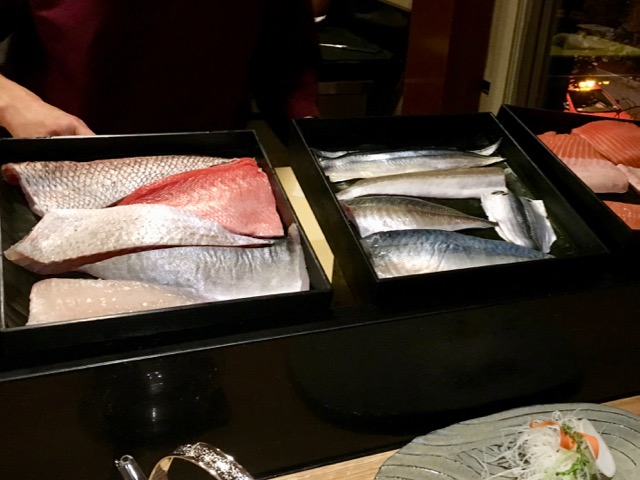Our sashimi and sushi course started visually with "daikon and other sashimi garnishes" 刺身のつま and freshly grated wasabi artfully displayed on a beautiful plate. We were served two kinds of sashimi soy sauce, one with grated ginger one without.
Prepared fillets and blocks of fish for sashimi and sushi served at traditional sushi bars in Japan are usually placed in wooden boxes which are called "Neta-bako" ネタ箱. At Sushi Taro, they went further by displaying these boxes in front of the guests and describing all the sashimi items available for the evening at the start of the sushi and sashimi course. We made mental notes of our favorites throughout the presentation and selected those "must have" items when we are then invited to choose. We also deferred to the chef's choice on any other selections and have never ever been disappointed. This evening, we noticed three different kinds of "uni" ウニ sea urchin (left box). They were uni from Maine (back left), California (front left ) and Hokkaido 北海道, Japan (front right). The center box was all tuna, bluefin tuna ootoro 大トロ(right) from Boston, chutoro 中トロ (back left) and akami 赤身 (front left).
The left box below was all white flesh "shiromi" 白身 fish including "madai" まだい sea bream and "hirame" ヒラメ flounder or flat fish. The right box was all "hikarimono" 光り物 or blue skinned fish. There were two more boxes on the right, one with partial view, contained several kinds of salmon and arctic char. The right most box which is not in the pictures contained "raw" octopus legs 生ダコの足 and ankimo あん肝 among other items.
We would have liked to try everything but, of course, we could not. We asked for our "must-have" items of uni, raw octopus, and ankimo. Beside these boxes, shell fish were also displayed on an ice filled large earthen bowl. Today's choices were scallops and abalone. We choose the scallop. We asked Masaya to provide us with his choice of sashimi and sushi to round out the selection. (That is indeed the whole idea behind "Omakase" おまかせ ; let the chef choose for you).
The uni was our first sashimi. While we have eaten each type of uni separately in the past, we had never had the opportunity for an "uni tasting" to directly compare their different characteristics. I was so eager to taste them and forgot to take a picture. Chef Masaya served them with salt on the side. All the uni was wonderful. It was a pleasure to experience the characteristic variations of each type side by side. Within the family of Uni, the California uni was it's usual brash self; bright golden yellow, creamy with a nice custard consistency and mild fresh ocean taste. The Maine uni was the country cousin with a firmer slightly grainy feel and somewhat gamey but pleasant taste. My expectations were high for the Hokkaido uni (especially since I am from Hokkaido). The Hokkaido uni was the demure dignified cousin; smaller in size than the rest with a denser creaminess than the California uni and subtle flavor. Masaya said the Hokkaido uni was "Bafun-uni" バフンウニ. It was so named because of its short spikes and round shape resembling "bafun" or horse droppings (not a particularly appetizing, yet oddly descriptive name). We could certainly enjoy each kind of uni any day.
The next was a "raw" octopus leg. Most of the octopus legs we can have here, for that matter even in Japan, are pre-boiled since the octopus flesh is very perishable. I do not recall eating "raw" octopus in the U.S. The last we had was at "Tako Grill" in Kuroishi 黒石市, Aomori 青森県, Japan. In the picture below, on the left were nice cross slices of leg after the skin had been removed. On the right were the octopus leg "suckers" 吸盤. The leg had a soft consistency. It was sweet, and quite a different experience from pre-boiled octopus. The suckers had a nice crunchy almost cartilage-like snap to it. I particularly liked the sucker.
Next was ootoro. Chef Masaya sliced it rather thin and shallowly scored it on the back ("Kakushi bocho" 隠し包丁or hidden knife work) since ootoro can have inter-veining "suji" 筋 or sinew. It looked and tasted almost like well marbled Japanese beef. All the tuna was, of course, excellent. Next was grilled sea eel or anago アナゴ accompanied by deep fried strings and grilled Tokyo scallion (top right).
Chef Masaya knows that we are not big eaters, and adjusted the portions by serving us more sashimi than sushi. After this, we had a few sushi items. I particularly remember the chutoro tuna and tai sea bream.
more to come including dessert. To be continued......







No comments:
Post a Comment